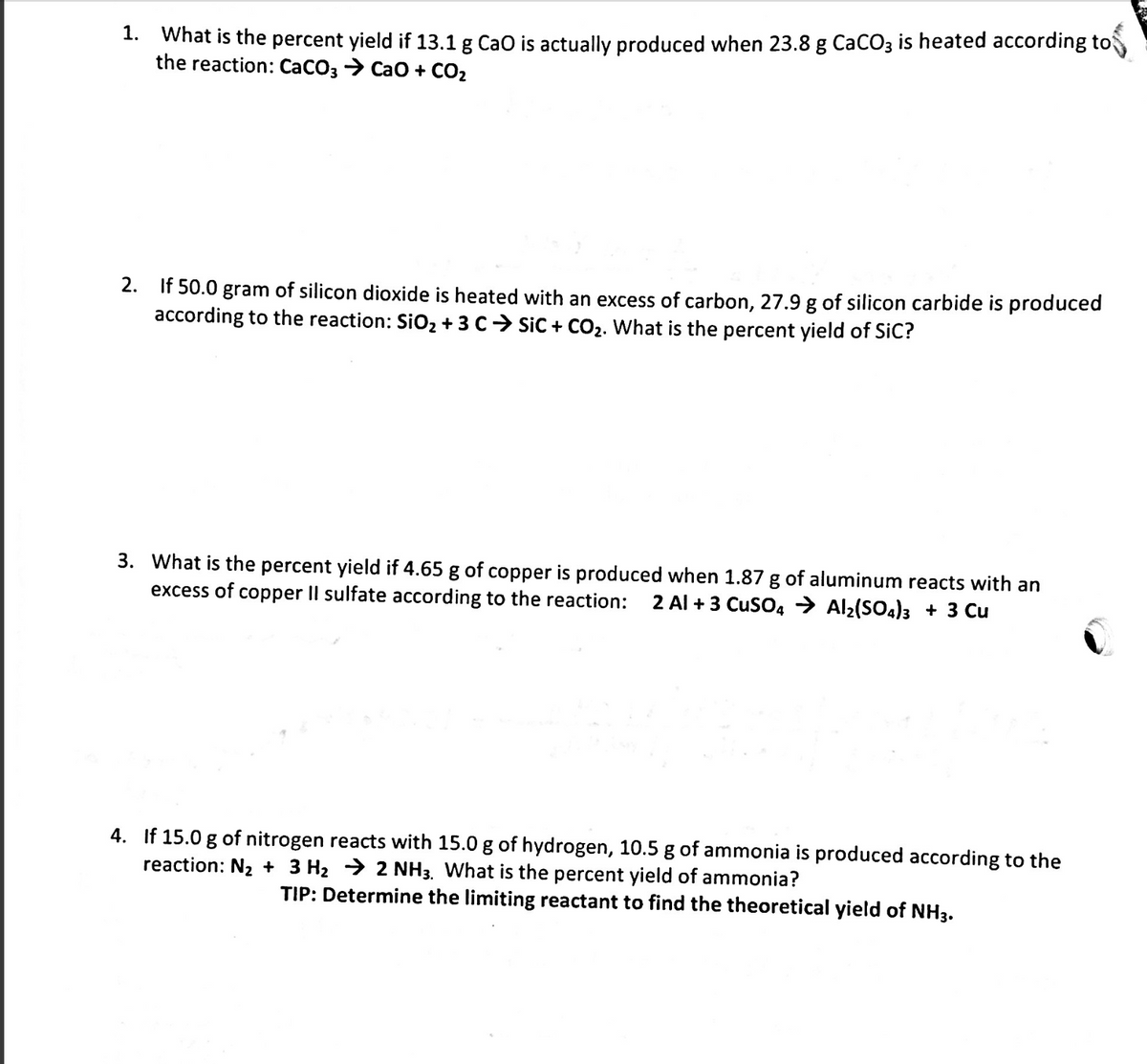1. What is the percent yield if 13.1 g Cao is actually produced when 23.8 g CaCO3 is heated according to the reaction: CaCO3 → CaO + CO2 2. If 50.0 gram of silicon dioxide is heated with an excess of carbon, 27.9 g of silicon carbide is produced according to the reaction: SiO2 + 3 C→ SiC + CO2. What is the percent yield of SiC? 3. What is the percent yield if 4.65 g of copper is produced when 1.87 g of aluminum reacts with an excess of copper Il sulfate according to the reaction: 2 Al +3 CuSO, → Al2(SO4)3 + 3 Cu 4. If 15.0 g of nitrogen reacts with 15.0 g of hydrogen, 10.5 g of ammonia is produced according to the reaction: N2 + 3 H2 → 2 NH3. What is the percent yield of ammonia? TIP: Determine the limiting reactant to find the theoretical yield of NH3.
1. What is the percent yield if 13.1 g Cao is actually produced when 23.8 g CaCO3 is heated according to the reaction: CaCO3 → CaO + CO2 2. If 50.0 gram of silicon dioxide is heated with an excess of carbon, 27.9 g of silicon carbide is produced according to the reaction: SiO2 + 3 C→ SiC + CO2. What is the percent yield of SiC? 3. What is the percent yield if 4.65 g of copper is produced when 1.87 g of aluminum reacts with an excess of copper Il sulfate according to the reaction: 2 Al +3 CuSO, → Al2(SO4)3 + 3 Cu 4. If 15.0 g of nitrogen reacts with 15.0 g of hydrogen, 10.5 g of ammonia is produced according to the reaction: N2 + 3 H2 → 2 NH3. What is the percent yield of ammonia? TIP: Determine the limiting reactant to find the theoretical yield of NH3.
Chemistry: Matter and Change
1st Edition
ISBN:9780078746376
Author:Dinah Zike, Laurel Dingrando, Nicholas Hainen, Cheryl Wistrom
Publisher:Dinah Zike, Laurel Dingrando, Nicholas Hainen, Cheryl Wistrom
Chapter11: Stoichiometry
Section: Chapter Questions
Problem 96A
Related questions
Question

Transcribed Image Text:1. What is the percent yield if 13.1 g Cao is actually produced when 23.8 g CaCO3 is heated according to
the reaction: CaCO3 > Cao + CO2
2. If 50.0 gram of silicon dioxide is heated with an excess of carbon, 27.9 g of silicon carbide is produced
according to the reaction: SiO2 + 3 C> Sic + CO2. What is the percent yield of SiC?
3. What is the percent yield if 4.65 g of copper is produced when 1.87 g of aluminum reacts with an
excess of copper II sulfate according to the reaction:
2 Al + 3 CuSO4 > Al2(SO4)3 + 3 Cu
4. If 15.0 g of nitrogen reacts with 15.0 g of hydrogen, 10.5 g of ammonia is produced according to the
reaction: N2 + 3 H2 > 2 NH3. What is the percent yield of ammonia?
TIP: Determine the limiting reactant to find the theoretical yield of NH3.
Expert Solution
This question has been solved!
Explore an expertly crafted, step-by-step solution for a thorough understanding of key concepts.
This is a popular solution!
Trending now
This is a popular solution!
Step by step
Solved in 3 steps with 3 images

Knowledge Booster
Learn more about
Need a deep-dive on the concept behind this application? Look no further. Learn more about this topic, chemistry and related others by exploring similar questions and additional content below.Recommended textbooks for you

Chemistry: Matter and Change
Chemistry
ISBN:
9780078746376
Author:
Dinah Zike, Laurel Dingrando, Nicholas Hainen, Cheryl Wistrom
Publisher:
Glencoe/McGraw-Hill School Pub Co


Chemistry
Chemistry
ISBN:
9781305957404
Author:
Steven S. Zumdahl, Susan A. Zumdahl, Donald J. DeCoste
Publisher:
Cengage Learning

Chemistry: Matter and Change
Chemistry
ISBN:
9780078746376
Author:
Dinah Zike, Laurel Dingrando, Nicholas Hainen, Cheryl Wistrom
Publisher:
Glencoe/McGraw-Hill School Pub Co


Chemistry
Chemistry
ISBN:
9781305957404
Author:
Steven S. Zumdahl, Susan A. Zumdahl, Donald J. DeCoste
Publisher:
Cengage Learning

Chemistry: An Atoms First Approach
Chemistry
ISBN:
9781305079243
Author:
Steven S. Zumdahl, Susan A. Zumdahl
Publisher:
Cengage Learning

Chemistry for Engineering Students
Chemistry
ISBN:
9781285199023
Author:
Lawrence S. Brown, Tom Holme
Publisher:
Cengage Learning

Chemistry: The Molecular Science
Chemistry
ISBN:
9781285199047
Author:
John W. Moore, Conrad L. Stanitski
Publisher:
Cengage Learning